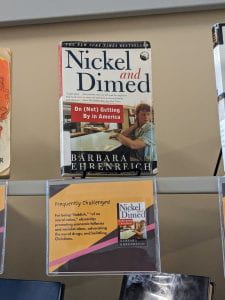During the first week of October (1-7 October 2023), libraries across the nation observed Banned Books Week, which recognizes “the freedom to read and spotlights current and historical attempts to censor books in libraries and schools.” Banned Books Week has since passed, but challenges to remove books from libraries continue at an alarming rate. That’s why the UWT Library continues to highlight banned and challenged books through our Banned Books Display.

A book ban can mean a few different things. Marshall University defines a banned book as a book that “has been removed from a library, classroom,” or other places where people commonly access information. Meanwhile, PEN America specifically defines a school book ban as: “any action taken against a book based on its content and as a result of parent or community challenges, administrative decisions, or in response to direct or threatened action by lawmakers or other governmental officials, that leads to a previously accessible book being either completely removed from availability to students, or where access to a book is restricted or diminished.”
A challenge, meanwhile, is simpler to define. A challenge simply refers to a request for a book to be removed from a place where people commonly access information. What makes book challenges notable is not the challenges themselves, but the number of challenges which a book may receive. Some books, as you’ll find, receive far more challenges than others, and for very particular reasons.
Book bans and challenges have been on the rise in recent years. The American Library Association (ALA) has been tracking reports of book bans and challenges for over 20 years, and in 2022 the numbers reached a record high with “2,571 unique titles targeted for censorship.” Compare that to the 1,858 unique titles in 2021, and 223 unique titles in 2020, and a concerning trend starts to take shape.
On top of these numbers is the estimation made by the ALA’s Office for Intellectual Freedom (OIF) that anywhere from “82-97% of challenges remain unreported.” An analysis done by The Washington Post notes that a significant number of challenges reported are initiated by a small handful of people–60% of the challenges in the 2021-2022 school year were initiated by 6% of challengers.
However, such numbers obfuscate the resources and vast networks that have formed in recent years to structurally support challengers. One such network, formed in 2021, is Moms for Liberty. The chairman for the group in Florida, Jennifer Pippin, received information for challenges from a group of volunteers, but the 68 resulting challenges submitted to the school district were under Pippin’s name.
The books targeted by Pippin and other challengers aren’t random either. A PEN America study by Jonathan Friedman and Nadine Farid Johnson show that between July 1, 2021 and June 30, 2022, titles featuring “LGBTQ+ themes, protagonists, or prominent secondary characters” accounted for 41% of banned/challenged books. Following that closely is books featuring characters of color at 40%. In many cases, books targeted for censorship feature both.
At this point you might be thinking: so what? While unfortunate, the fact that books featuring marginalized groups are the primary targets of censorship isn’t exactly surprising.
Let’s take a look back at the display.

Of the nearly 40 books on display, only one (1) of them is nonfiction. The rest are fiction. This is not an accident. Michael Fischer, discussing the work of Helen Small on the value of humanities, says that studying the humanities, including reading literature, “makes us better citizens: more tolerant of others’ views, more skilled in critical thinking, better able to engage constructively in collective democratic decision-making.” In other words, to focus on the first point, reading fiction helps us develop empathy.
Contrary to what some may believe, empathy isn’t an attribute that some people have and others don’t. It’s a skill, and like any other skill, it requires practice. That said, we don’t always get opportunities in our day to day lives to practice empathy. Enter fiction. While it shouldn’t be treated as a perfect substitute for real-life experiences and real-life voices, fiction is informed by those things, and so can be a great starting place for understanding views that differ from our own.
With this in mind, it can be inferred that by ensuring books featuring characters of color and LGBTQ+ are unavailable, or at least more difficult to access for many people, book challengers deliberately want to prevent any sort of tolerance for people belonging to these historically marginalized groups.
In many cases this is merely implicit and comes with a degree of plausible deniability. After all, we’re just looking out for the kids, right? In the case of Moms for Liberty cofounder Tiffany Justice, it’s just a matter of curation: “You wouldn’t have the same books in a medical college that you would in a seminary, and just because a book is printed doesn’t mean that it belongs in a children’s library.”
Others are more explicit, as in the case of a Georgia woman who challenged books with LGBTQ+ themes: “You can’t just put it out there as if it’s okay for everybody, because if people think it’s okay, then what are they going to do?”
As for what we can do in the face of such widespread attempts at censorship, there are more options than you may think:
- The ALA has a page about how to get involved, which includes ideas like staying up to date about challenges at your local library
- Read up on the UW Libraries policy regarding book challenges
- Read banned books! While some challengers do read the entirety of books they want withdrawn from public access, many only ever read excerpts that are taken out of context. By reading a banned book, you become more fully informed.
- Talk about banned books! Many banned books deal with complex, sensitive, even uncomfortable topics. Talking with others about these topics and how you react to them can help you better understand their importance.
If you decide you need a banned book to read, visit the second floor of Tioga Library Building (TLB), where our Banned Books Display will be up for the entirety of autumn quarter. All books on display are available for check out.